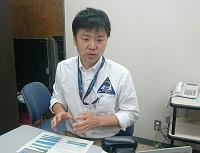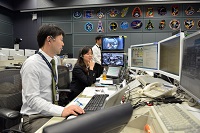Kibo-ABC members talk with JAXA flight director (J-FLIGHT) about the process of the ISS/Kibo space experiment
Last Updated:
June 27, 2016
"How much time and effort is required to plan an experiment?"
"What kind of preparation would be beneficial to make the experiment successful?"

Mr. Ichimura at the Kibo-ABC monthly web conference
Mr. Shuichi Ichimura, a JAXA flight director, joined the Kibo-ABC regular monthly web conference on June 16th to give a presentation about the ISS/Kibo experiment preparation process.
The goal of his presentation was to understand:
1) How much time and effort is required to plan an experiment and,
2) What kind of preparation would be beneficial to make the experiment successful.
The presentation began with an explanation of the generic template for the experiment preparation process. During the explanation, he noted the importance of adequate crew procedure development and how it would affect the result of the experiment.

Mr. Ichimura on console as JEM(Kibo) Flight Director
He also mentioned that the onboard plan was coordinated with other international partners based on each task's priority, planning requirements and restrictions. For onboard experiments, he described how the on-console team and the science team prepared for unexpected situations. After the explanation, some examples of actual preparation processes were introduced for wrap-up.
All the Kibo-ABC members had a great time learning more deeply about preparations for their future experiments at ISS/Kibo.
Message from Mr. Shuichi Ichimura:
The reason why I wanted to participate today was to meet smart people from Asia with great interest in human space programs. I hope you were able to understand the ops preparation process and tips to make your experiment successful. KIBO is an experiment module waiting for exciting experiments and I am very much looking forward to working with you all in the near future!
Q&A
 Flight/Crew assignment for samples (Malaysia)
Flight/Crew assignment for samples (Malaysia)
Q. From our last experience during Malaysia Astronaut program 2007, only him (astronaut) can brought the sample return to the Earth (for Malaysia experiment). If, in the case of we have another sample return remaining in ISS (that still on the period of on board experiment) can we assign any astronaut to bring it back?
A. Yes. Depending on the period of the science and crew's task assignment, our planners will coordinate with other International Partners to assign a crew member.
 Module of the ISS for experiments (Malaysia)
Module of the ISS for experiments (Malaysia)
Q. From our last astronaut mission 2007, the experiment was conducted (and must be conducted) in Russian module because the Malaysian Astronaut was declared under Russian Flight seat. What if in the case that the experiment have to be conducted also in Kibo (Japanese module) or other module? Can we do that?
A. Yes. JAXA experiments will basically be held in Kibo, utilizing Kibo's resource. Experiments using other modules need to be agreed and coordinated with other International Partners.
 Qualification for flight hardware (Malaysia)
Qualification for flight hardware (Malaysia)
Q. During our astronaut mission 2007, to simplify space qualification of material that we want to bring to ISS was by using the already space qualified component or instrument e.g Fluid Processing Apparatus (FPA) that we got it from NASA. We also brought Malaysian Traditional Spinning Top what and it was space qualified by Russian (our seat provider). My question is who is the actual authorized body for space qualification before an experiment is declared safe to be conducted in space? Is it different authorization body for different seat provider?
A. An experiment safety will be reviewed at the Safety review as in the chart. For JAXA experiment, JAXA PSRP (Payload Safety Review Panel), which is franchised by NASA will be responsible for qualification.
 Example of unacceptable experiment (Singapore)
Example of unacceptable experiment (Singapore)
Q. For onboard pressurized experiment, what are the no-go types of experiment?
A. Any experiment which has a potential concern of crew safety will be no-go. Items listed in the call for proposals are good examples.
POINTS of CONSIDERATION
Following points are considered as unsafe in ISS/Kibo
- Usage of dangerous material/objects
- Sprinkling a large amount of water into Kibo cabin
- Releasing a certain amount of gaseous, especially the one ISS doesn't have capability of elimination. e.g. N2
- Scattering tiny articles such as bolts and nuts, pieces of paper
- Usage of high speed spinning objects with large mass
- Items which have sharp edges
Following points are considered as impractical in ISS/Kibo
- Two crew tasks
- Long duration of crew time
- Sacrificing crew's rights, privacies
- Requires to terminate air flow in cabin
- Blocks crew's emergency evacuation path. e.g. closing hatches
 Types of crew procedures (Singapore)
Types of crew procedures (Singapore)
Q. For procedures, is it better to use flow chart or step by step instructions?
A. For procedures, step by step is better since crew usually uses procedures written step by step. Flow chart is useful when if the experiment is complicated and it would be better to have a big picture for the crew. Flow chart or block diagram is also useful when the action is different depending on the result of each step (for example, if the result of step 2 is A, perform step3, if B, perform step 4.)
 Plant growth in micro gravity (Thailand)
Plant growth in micro gravity (Thailand)
Q. If the seeds experiment onboard the Kibo-Module proves unsuccessful, would genetically modifying the seeds be a viable option to try and get seeds to grow in zero-gravity?
A. From the past experience, seeds never failed to grow in microgravity environment and do not need to be genetically modified.
 Process for Education Payload Observation Pilot Missions (EPO) (Vietnam)
Process for Education Payload Observation Pilot Missions (EPO) (Vietnam)
Q. According to news published on website of KIBO, apart from scientific experiments, a several Education Payload Observation Pilot Missions have been conducted, including art projects such as: Message in a Bottle or Dewey's Forest, so could you tell us about the preparation of these special experiments? And did they require all the preparation process like the others?
A. Yes, Education Payload Observation also has to go thru the same process. All missions need to be proved that they are safe to the crew, require procedure development to accomplish the objectives, and of course be coordinated among International Partners to plan the mission to make it happen.



 Flight/Crew assignment for samples (Malaysia)
Flight/Crew assignment for samples (Malaysia)
 Module of the ISS for experiments (Malaysia)
Module of the ISS for experiments (Malaysia)
 Qualification for flight hardware (Malaysia)
Qualification for flight hardware (Malaysia)
 Example of unacceptable experiment (Singapore)
Example of unacceptable experiment (Singapore)
 Types of crew procedures (Singapore)
Types of crew procedures (Singapore)
 Plant growth in micro gravity (Thailand)
Plant growth in micro gravity (Thailand)
 Process for Education Payload Observation Pilot Missions (EPO) (Vietnam)
Process for Education Payload Observation Pilot Missions (EPO) (Vietnam)


